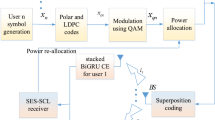Abstract
The conventional straightforward relaying scheme named decode-and-forward (DF) protocol is used at relay to decode the data received from source and forward the decoded data to the destination to improve the spatial diversity gain. Although it is a simple scheme, the total resource efficiency is low for multiple sources. Superposition coding has been known as a spectral efficient technique in wireless networks. However, when it is applied to the uplink multiple access relay systems, it suffers from performance degradation caused by the power allocation between the symbols of multiple sources. In this paper, we propose to remedy this problem by using hierarchical modulation at the source node and superposition coding at the relay node to enhance the bit energy. We investigate how hierarchical modulation can be incorporated and optimized with superposition coding. Specially, we discuss the capacity behavior of the proposed scheme and compare with the baseline, namely the capacity behavior of the existing DF scheme and the capacity behavior of the superposition coding. Our results are encouraging in that superposed hierarchical modulation significantly improves the better block error rate and capacity performance in multiple access relay channels.
Similar content being viewed by others
References
Azarian K., El Gamal H., Schniter P. (2005) On the achievable diversity multiplexing tradeoff in half-duplex cooperative channels. IEEE Transactions on Information Theory 51(12): 4152–4172
Laneman J. N., Tse D. N. C., Wornell G. W. (2004) Cooperative diversity in wireless networks: Efficient protocols and outage behavior. IEEE Transactions on Information Theory 50(12): 3062–3080
Kramer G., Gastpar M., Gupta P. (2005) Cooperative strategies and capacity theorems for relay networks. IEEE Transactions on Information Theory 51(9): 3037–3063
Dai M., Sung C. H. (2009) A distributed on-off amplify-and-forward protocol for the fading parallel relay channel. IEEE Communications Letters 13(9): 643–645
Behbahani A. S., Eltawil A. M. (2009) Amplify-and-forward relay networks under received power constraint. IEEE Transactions on Wireless Communications 8(11): 5422–5426
Lee I.-H., Kim D. (2007) BER analysis for decode-and-forward relaying in dissimilar Rayleigh fading channels. IEEE Communications Letters 11(1): 52–54
Kim T. T., Gaire G., Skoqlund M. (2008) Decode-and-forward relaying with quantized channel state feedback: An outage exponent analysis. IEEE Transactions on Information Theory 54(10): 4548–4564
Hunter, T. E., Nosratinia, A. (2002). Cooperative diversity through coding. In IEEE International Symposium on Information Theory, (p. 220), June 2002.
Stefanov A., Erkip E. (2004) Cooperative coding for wireless networks. IEEE Transactions on Communications 52(9): 1470–1476
Rankov B., Wittneben A. (2007) Spectral efficient protocols for half duplex fading relay channels. IEEE Journal on Selected Areas in Communications 25(2): 379–389
Lee K., Cho D. (2007) Hierarchical constellation based adaptive relay scheme in multi-hop networks. IEEE Communications Letters 11(3): 225–227
Wang, S., Kwon, S., & Yi, B. K. (2008). On enhancing hierarchical modulation. In IEEE International Symposium on Broadband Multimedia Systems and Broadcasting (pp. 1–6), April 2008.
Popovski, P., & de Carvalho, E. (2007). Spectrally-efficient wireless relaying based on superposition coding. In Proceedings of IEEE VTC-Spring, (pp. 2936–2940), April 2007.
Hausl C., Hagenauer J. (2007) Relay communication with hierarchical modulation. IEEE Communications Letters 11: 64–66
Larsson E. G., Vojcic B. R. (2005) Cooperative transmit diversity based on superposition modulation. IEEE Communications Letters 9(9): 778–780
Morimoto, M., Okada, M., & Komaki, S. (1995). A hierarchical image transmission system in a fading channel. In Proceedings of IEEE ICUPC (pp. 769–772), November 1995.
Hausl, C., & Dupraz, P. (2006). Joint network-channel coding for the multiple-access relay channel. In International workshop on wireless ad-hoc and sensor networks(Vol. 3, pp. 817–822).
Jun, Y., & Ghosh, M. (2007). A cooperative modulation scheme for wireless relay networks. In Proceedings of IEEE VTC (pp. 1628–1632).
Lee, S. Y., & Whang, K. C. (2008). A collaborative cooperation scheme using hierarchical modulation. In Proceedings of VTC 2008-fall (pp. 1–5).
Author information
Authors and Affiliations
Corresponding author
Rights and permissions
About this article
Cite this article
Meng, Y., Liu, G., Shen, G. et al. Superposition Coding and Analysis for Cooperative Multiple Access Relay System. Wireless Pers Commun 70, 1011–1028 (2013). https://doi.org/10.1007/s11277-012-0743-y
Published:
Issue Date:
DOI: https://doi.org/10.1007/s11277-012-0743-y




